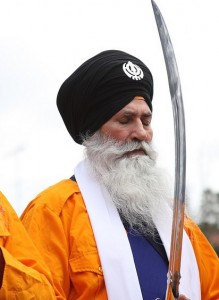 Unfortunately at many points in our history, true and authentic Sikh rehit became something that was rare. After numerous holocausts and extended periods of living in the jungles of Punjab, differences in rehit crept into the Sikh Panth.
Unfortunately at many points in our history, true and authentic Sikh rehit became something that was rare. After numerous holocausts and extended periods of living in the jungles of Punjab, differences in rehit crept into the Sikh Panth.
The rehit is a code of conduct which has been passed down from the original Amrit Sanchaar in an oral fashion. Old rehitnamas, like the one written by Bhai Desa Singh state, (in the seventh stanza) “that rehit which the five utter, keep that steadfast in your mind” and later in the ninth stanza, “that is the first rehit, the one which the five Singhs said in the Pahul ceremony.”
The Khalsa Rehit suffered some dilution in the 18th and 19th century. But the Malwa area of Punjab had some areas where this rehit was preserved. Certain movements like the Namdhari movement, which originally had amazing rehit and was originally not a Gurudom, came out of Malwa. Deras like Baba Ajaipal Singh were known for strict rehit. So the original Khalsa rehit was not lost, it was kept in some places.
How can the AKJ substantiate that their rehit is authentic? The answer comes from looking at historical documents and sources. Keski is a rehit that is clear due to bhat vehees, which are the most historic and authentic documents from the time of the first amrit sanchaar. In these vehis, the records of the original amrit sanchaar list “Kesgee” as a kakaar. The Akhand Kirtani Jatha is one of the only Sikh groups that still preserves Keski as a kakaar to this day. (For more information, see question/answer on Keski).
Along with his many other qualities, Bhai Randhir Singh was an ardent seeker of truth. He was not bound by many of the Hindu-influenced practices that had infiltrated the Panth before his time. He was also not bound by following a belief simply because it was a tradition and therefore assumed to be a “maryada”. Bhai Randhir Singh sought to look to Gurbani and Sikh history to see what was the authentic Sikh lifestyle and to revive that lifestyle during his life. Keski rehit was revived because of Bhai Randhir Singh even though it had been on the decline since the reign of Maharaja Ranjit Singh. Bhai Randhir Singh cared only for the truth. He was not a “Sant”-like figure who was bound by the beliefs of a predecessor from the same jatha or group.
So it is fair to say that while the Akhand Kirtani Jatha is a relatively new Jatha, only around 100 years old, that it has been carrying on the Sikh rehit as it existed during the time of Guru Gobind Singh Jee and after the time of Guru Gobind Singh Jee, although the true and authentic Sikh rehit may have become rare at various points in our history.
It is commonplace for many Sikh organizations to claim an uninterrupted connection back to the time of Guru Gobind Singh Jee. A study of Sikh history casts doubt on any such claims. Sikhs should look at their history critically to make the proper judgments on this question. Many groups within the panth claim that their institution has been passed on from the lineage of famous Gursikhs from the time of Sri Guru Gobind Singh Jee. For example, some claim their lineage comes from Bhai Daya Singh Ji while another group may claim that their unbroken lineage comes from Shaheed Bhai Mani Singh Ji. However, an analysis of these groups demonstrates that their practices are not always in line with the great Gursikhs they claim an association with. For example, Bhai Daya Singh Ji mentions to eat out of Sarbloh (iron utensils) from other Amrit Dharis but the group who claims to be descended from his leadership does not follow this practice (see article on eating from Amrit Dharis). Shaheed Bhai Mani Singh Ji describes the method of how panj pyareh teach new Amrit Dharis how to jap naam with the tip of their tongue but the groups claiming a direct lineage to Bhai Mani Singh Ji do not follow this practice (see article on Naam Dhrir). Secondly, the process of giving authority to one being and passing it down to a student is not in accordance with Gurmat. Sri Guru Gobind Singh Ji gave authority to Punj Pyareh and every panthic institution in the past was governed by the Punj Pyareh. No group can claim to be fully following puraatan (old time) traditions when they have abandoned the tradition of Punj Pyareh governance.